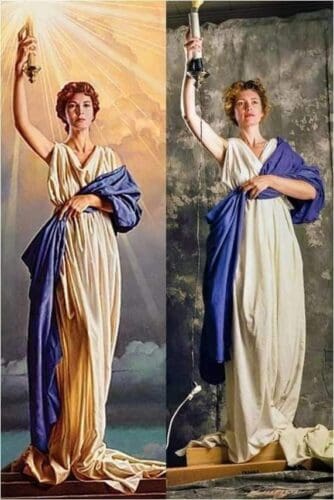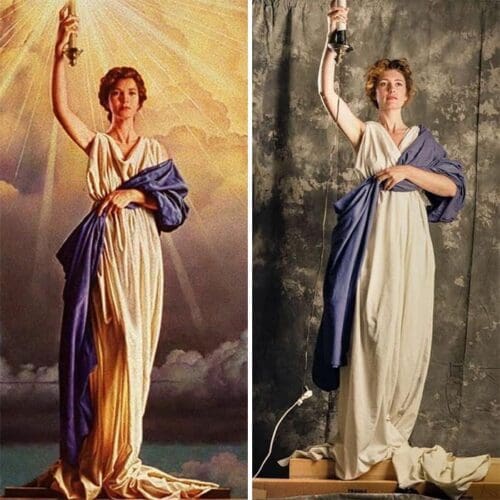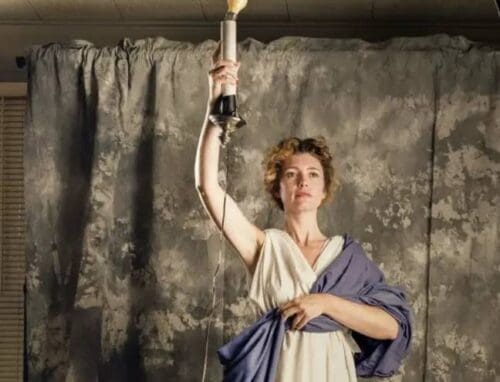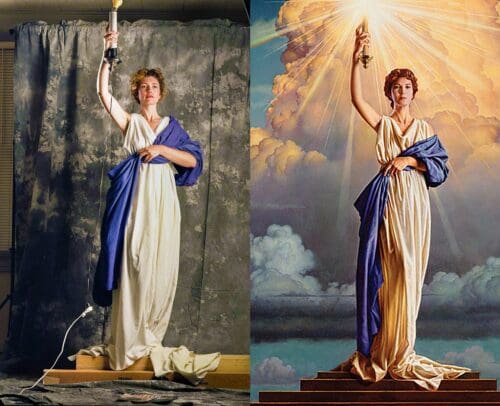jenny joseph, jenny joseph columbia pictures
jenny joseph columbia pictures





Iconic Animation: The renowned “Torch Lady” animation has graced the start of countless films since 1993 under the Columbia Pictures logo.
Curiosity Sparked: Despite the logo’s ubiquitous presence, few have delved into the identity of the woman behind the torch.
Meet Jenny Joseph: The enigmatic figure is none other than Jenny Joseph.
New Orleans Connection: In 1991, at the age of 28 and recently pregnant, Jenny worked as a page designer for The Times-Picayune in New Orleans.
Unlikely Model: Photographer Kathy Anderson, a colleague of Jenny’s, was approached by painter and illustrator Michael Deas to capture reference photos for a new matte painting commissioned by Columbia Pictures.
On-the-Whim Modeling: Jenny, on her lunch break, agreed to model for Deas, and they transformed Kathy’s apartment into a makeshift studio using bed sheets and a table lamp.
Digital Transformation: Deas digitally painted the reference images, creating the new logo, later brought to life through a 3D animation by Synthespian Studios.
Houston Muralist and Mother: Today, Jenny has transitioned into a Houston muralist and is a mother of two.
Modest Compensation: Despite her pivotal role in cinematic history, Jenny received “very little” financial compensation for her contribution.
Cinematic Fame: In a 2004 interview, Jenny expressed contentment, stating, “When I go to the movies, I get my 15 minutes of fame, the kids get a kick out of it.”
Evolution of the Logo: The Columbia Pictures logo, featuring the torch lady officially named “Columbia,” has undergone transformations since its debut in 1924.
Statue of Liberty Inspiration: The torch lady draws inspiration from the Statue of Liberty.
Original Incarnation: The first version of the logo, in 1924, showcased a female Roman soldier holding a shield and a stalk of wheat, distinct from the present-day design.
Next Time You Watch: With this newfound knowledge, the next time you view a post-1993 Columbia Pictures film, remember the unassuming graphic designer who posed for this iconic logo during her lunch break 30 years ago.
A Salute to Jenny Joseph: To Jenny Joseph, the face behind the torch lady, we salute you for your role in cinematic history.
jenny joseph fast facts



Founding Years: Established in 1918 by siblings Harry and Jack Cohn along with Joel Brandt, Columbia Pictures, initially known as CBC Film Sales Corporation, stands as one of Hollywood’s oldest studios.
Early Ventures: During its early years, the studio primarily produced low-budget films, prompting a rebranding in 1924 as Columbia Pictures, embodying a more sophisticated image.
Symbolic Torchbearer: The studio’s name and its emblem, featuring a torch-bearing female, pay homage to Lady Columbia, a somewhat forgotten female symbol representing the United States.
Logo Evolution: The Columbia Pictures logo has undergone five major revisions since its inception in 1924.
1924 Logo: The original design showcased a female Roman soldier holding a shield and a stalk of wheat.
1928 Alteration: The revised version featured a woman draped in the flag, carrying a torch and donning the stola and palla of ancient Rome.
Evelyn Venable Influence: The 1928 illustration was based on actress Evelyn Venable, recognized for voicing The Blue Fairy in Disney’s Pinocchio.
Modern Transformation: In 1992, a significant redesign of the logo took place, coinciding with its cinematic debut the following year.
Creative Reinvention: Scott Mednick and The Mednick Group, hired by Peter Guber, collaborated to refresh logos for Sony Pictures’ entertainment properties.
Digital Repainting: Artist Michael Deas digitally repainted the logo, emphasizing a more “classic” appearance, hiring Jenny Joseph, a graphics artist from The Times-Picayune, as the model.
Color Scheme Change: The original American flag draping Lady Columbia was altered to white, orange, and blue.
Photo Shoot Insights: Photographer Kathy Anderson captured the iconic images in her New Orleans apartment during a four-hour photoshoot.
Model’s Story: Jenny Joseph, who assisted on her lunch break, shared the story of the photoshoot in a 2012 interview with WWL-TV.
Unexpected Legacy: Jenny Joseph’s face, captured in that lunchtime session, has graced the silver screen for 25 years, an unexpected and enduring legacy.
Deas’ Reflection: Michael Deas expressed surprise and gratification that his artwork, including Jenny Joseph’s contribution, not only persisted on the silver screen but also found a place in museums.
